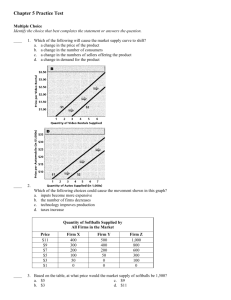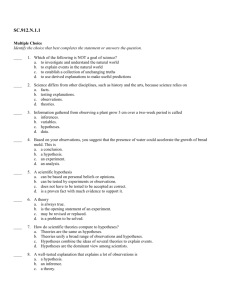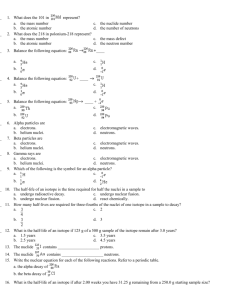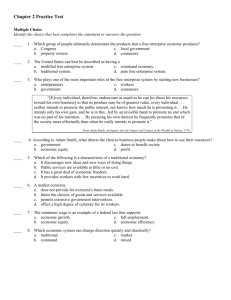Thermochemistry Test Preview - High School Chemistry
advertisement
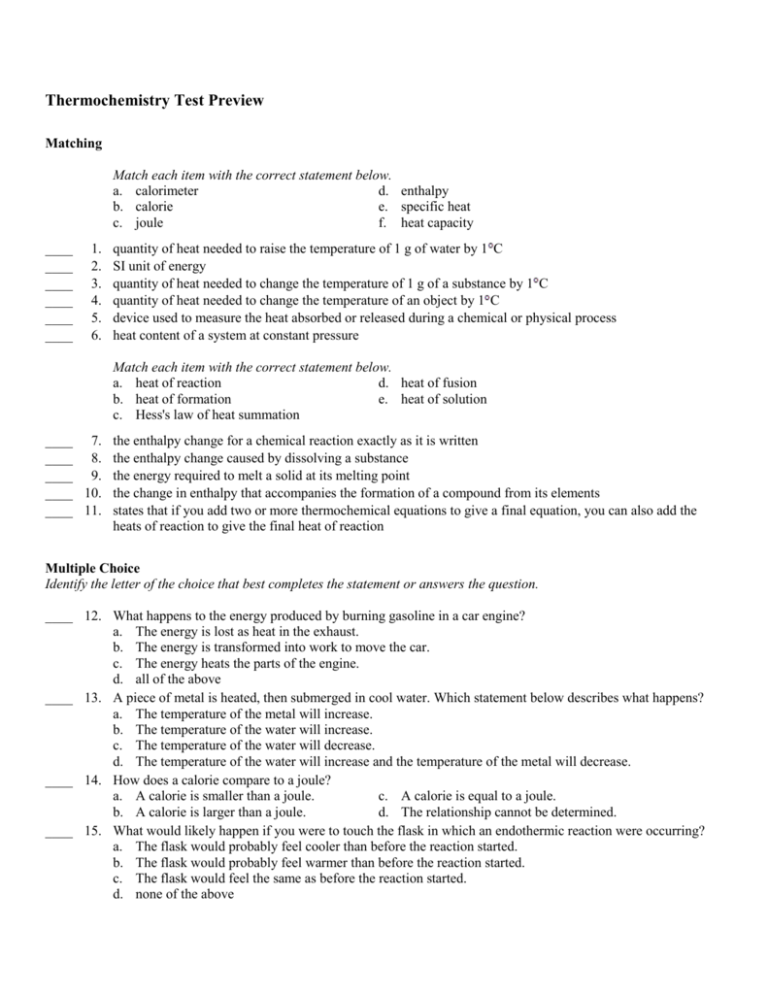
Thermochemistry Test Preview Matching Match each item with the correct statement below. a. calorimeter d. enthalpy b. calorie e. specific heat c. joule f. heat capacity ____ ____ ____ ____ ____ ____ 1. 2. 3. 4. 5. 6. quantity of heat needed to raise the temperature of 1 g of water by 1 C SI unit of energy quantity of heat needed to change the temperature of 1 g of a substance by 1 C quantity of heat needed to change the temperature of an object by 1 C device used to measure the heat absorbed or released during a chemical or physical process heat content of a system at constant pressure Match each item with the correct statement below. a. heat of reaction d. heat of fusion b. heat of formation e. heat of solution c. Hess's law of heat summation ____ 7. the enthalpy change for a chemical reaction exactly as it is written ____ 8. the enthalpy change caused by dissolving a substance ____ 9. the energy required to melt a solid at its melting point ____ 10. the change in enthalpy that accompanies the formation of a compound from its elements ____ 11. states that if you add two or more thermochemical equations to give a final equation, you can also add the heats of reaction to give the final heat of reaction Multiple Choice Identify the letter of the choice that best completes the statement or answers the question. ____ 12. What happens to the energy produced by burning gasoline in a car engine? a. The energy is lost as heat in the exhaust. b. The energy is transformed into work to move the car. c. The energy heats the parts of the engine. d. all of the above ____ 13. A piece of metal is heated, then submerged in cool water. Which statement below describes what happens? a. The temperature of the metal will increase. b. The temperature of the water will increase. c. The temperature of the water will decrease. d. The temperature of the water will increase and the temperature of the metal will decrease. ____ 14. How does a calorie compare to a joule? a. A calorie is smaller than a joule. c. A calorie is equal to a joule. b. A calorie is larger than a joule. d. The relationship cannot be determined. ____ 15. What would likely happen if you were to touch the flask in which an endothermic reaction were occurring? a. The flask would probably feel cooler than before the reaction started. b. The flask would probably feel warmer than before the reaction started. c. The flask would feel the same as before the reaction started. d. none of the above ____ 16. Which of the following is NOT a form of energy? a. light c. heat b. pressure d. electricity ____ 17. When energy is changed from one form to another, ____. a. some of the energy is lost entirely b. all of the energy can be accounted for c. a physical change occurs d. all of the energy is changed to a useful form ____ 18. If heat is released by a chemical system, an equal amount of heat will be ____. a. absorbed by the surroundings c. released by the surroundings b. absorbed by the universe d. released by the universe ____ 19. Which of the following is transferred due to a temperature difference? a. chemical energy c. electrical energy b. mechanical energy d. heat ____ 20. In an exothermic reaction, the energy stored in the chemical bonds of the reactants is ____. a. equal to the energy stored in the bonds of the products b. greater than the energy stored in the bonds of the products c. less than the energy stored in the bonds of the products d. less than the heat released ____ 21. A process that absorbs heat is a(n) ____. a. endothermic process c. exothermic process b. polythermic process d. ectothermic process ____ 22. When your body breaks down sugar completely, how much heat is released compared to burning the same amount of sugar in a flame? a. The body releases more heat. b. The body releases less heat. c. The body releases the same amount of heat. d. The body releases no heat. ____ 23. The quantity of heat required to change the temperature of 1 g of a substance by 1 C is defined as ____. a. a joule c. a calorie b. specific heat d. density ____ 24. A piece of candy has 5 Calories (or 5000 calories). If it could be burned, leaving nothing but carbon dioxide and water, how much heat would it give off? a. 500 calories c. 5000 joules b. 5 kilocalories d. Not enough information is given. ____ 25. How many joules are in 148 calories? (1 cal = 4.18 J) a. 6.61 J c. 148 J b. 35.4 J d. 619 J ____ 26. What is the amount of heat required to raise the temperature of 200.0 g of aluminum by 10 C? (specific heat of aluminum = 0.21 ) a. 420 cal c. 42,000 cal b. 4200 cal d. 420,000 cal ____ 27. What is the specific heat of a substance if 1560 cal are required to raise the temperature of a 312-g sample by 15 C? a. c. 0.033 0.99 b. d. 0.33 1.33 ____ 28. How many kilocalories of heat are required to raise the temperature of 225 g of aluminum from 20 C to 100 C? (specific heat of aluminum = 0.21 ) a. 0.59 kcal c. 85 kcal b. 3.8 kcal d. none of the above ____ 29. The heat capacity of an object depends in part on its ____. a. mass c. shape b. enthalpy d. potential energy ____ 30. Which of the following is a valid unit for specific heat? a. c. b. cal d. C ____ 31. When 45 g of an alloy, at 25 C, are dropped into 100.0 g of water, the alloy absorbs 956 J of heat. If the final temperature of the alloy is 37 C, what is its specific heat? a. c. 0.423 9.88 b. 1.77 d. 48.8 ____ 32. How can you describe the specific heat of olive oil if it takes approximately 420 J of heat to raise the temperature of 7 g of olive oil by 30 C? a. greater than the specific heat of water c. equal to the specific heat of water b. less than the specific heat of water d. Not enough information is given. ____ 33. The specific heat of silver is 0.24 ____ 34. ____ 35. ____ 36. ____ 37. ____ 38. . How many joules of energy are needed to warm 4.37 g of silver from 25.0 C to 27.5 C? a. 2.62 J c. 45.5 J b. 0.14 J d. 0.022 J Which of the following has the greatest heat capacity? a. 1000 g of water c. 1 g of water b. 1000 g of steel d. 1 g of steel Which of the following substances has the highest specific heat? a. steel c. alcohol b. water d. chloroform By what quantity must the heat capacity of an object be divided to obtain the specific heat of that material? a. its mass c. its temperature b. its volume d. its energy The amount of heat transferred from an object depends on which of the following? a. the specific heat of the object c. the mass of the object b. the initial temperature of the object d. all of the above What does the symbol H stand for? a. the specific heat of a substance b. the heat capacity of a substance c. the heat of reaction for a chemical reaction ____ 39. ____ 40. ____ 41. ____ 42. ____ 43. ____ 44. ____ 45. ____ 46. ____ 47. d. one Calorie given off by a reaction Standard conditions of temperature and pressure for a thermochemical equation are ____. a. 0 C and 101 kPa c. 0 C and 0 kPa b. 25 C and 101 kPa d. 25 C and 22.4 kPa The heat content of a system is equal to the enthalpy only for a system that is at constant ____. a. temperature c. pressure b. volume d. mass On what principle does calorimetry depend? a. Hess's law c. law of enthalpy b. law of conservation of energy d. law of multiple proportions How can the enthalpy change be determined for a reaction in an aqueous solution? a. by knowing the specific heat of the reactants b. by mixing the reactants in a calorimeter and measuring the temperature change c. by knowing the mass of the reactants d. The enthalpy change for this type of reaction cannot be determined. A chunk of ice whose temperature is –20 C is added to an insulated cup filled with water at 0 C. What happens in the cup? a. The ice melts until it reaches the temperature of the water. b. The water cools until it reaches the temperature of the ice. c. Some of the water freezes, so the chunk of ice gets larger. d. none of the above The amount of heat released by the complete burning of 1 mole of a substance is the ____. a. specific heat c. heat capacity b. heat of combustion d. heat of fusion Calculate the energy required to produce 7.00 mol Cl O on the basis of the following balanced equation. 2Cl (g) + 7O (g) + 130 kcal 2Cl O (g) a. 7.00 kcal c. 130 kcal b. 65 kcal d. 455 kcal What is the standard heat of reaction for the following reaction? Zn(s) + Cu (aq) Zn (aq) + Cu(s) ( H for Cu = +64.4 kJ/mol; H for Zn = –152.4 kJ/mol) a. 216.8 kJ released per mole c. 88.0 kJ absorbed per mole b. 88.0 kJ released per mole d. 216.8 kJ absorbed per mole Calculate H for the following reaction. C H (g) + H (g) C H (g) ( H for C H (g) = 52.5 kJ/mol; H for C a. –137.2 kJ b. –32.2 kJ ____ 48. Calculate the energy released when 24.8 g Na Na O(s) + 2HI(g) 2NaI(s) + H O(l) H = –120.00 kcal a. 0.207 kcal b. 2.42 kcal H (g) = –84.7 kJ/mol) c. 32.2 kJ d. 137.2 kJ O reacts in the following reaction. c. 48.0 kcal d. 3.00 10 kcal ____ 49. The amount of heat needed to melt one mole of a solid at a constant temperature is called ____. a. molar heat of fusion c. heat of reaction b. molar heat of solidification d. enthalpy ____ 50. During a phase change, the temperature of a substance ____. a. increases c. remains constant b. decreases d. may increase or decrease ____ 51. To calculate the amount of heat absorbed as a substance melts, which of the following information is NOT needed? a. the mass of the substance c. the change in temperature b. the specific heat of the substance d. the density of the sample ____ 52. What is the heat of solution? a. the amount of heat required to change a solid into a liquid b. the amount of heat absorbed or released when a solid dissolves c. the amount of heat required to change a vapor into a liquid d. the amount of heat released when a vapor changes into a liquid ____ 53. The H is ____. a. always negative b. always positive c. sometimes positive, sometimes negative d. always 0 ____ 54. When 1.0 g of solid NaOH ( H = –445.1 kJ/mol) dissolves in 10 L of water, how much heat is released? a. 445.1 kJ c. 11.1 J b. 405.1 kJ d. 11.1 kJ ____ 55. When 10 g of diethyl ether is converted to vapor at its boiling point, about how much heat is absorbed? (C H O, H = 15.7 kJ/mol, boiling point: 34.6 C) a. 2 kJ c. 0.2 kJ b. 2 J d. Not enough information is given. ____ 56. Hess's law ____. a. makes it possible to calculate H for complicated chemical reactions b. states that when you reverse a chemical equation, you must change the sign of H c. determines the way a calorimeter works d. describes the vaporization of solids ____ 57. Using a table that lists standard heats of formation, you can calculate the change in enthalpy for a given chemical reaction. The change in enthalpy is equal to ____. a. H of products minus H of reactants b. H of products plus H of reactants c. H of reactants minus d. H of products divided by H of reactants H of products ____ 58. The amount of heat involved in the synthesis of 1 mole of a compound from its elements, with all substances in their standard states at 25 C, is called ____. a. enthalpy c. standard heat of formation b. heat of reaction d. heat of solidification ____ 59. The symbol H stands for the ____. a. specific heat of a substance b. heat capacity of a substance c. heat of reaction for a chemical reaction d. standard heat of formation for a compound H for the formation of rust (Fe O ) is –826 kJ/mol. How much energy is involved in the formation of 5 grams of rust? a. 25.9 kJ c. 66 kJ b. 25.9 J d. 66 J ____ 61. Calculate H for the reaction of sulfur dioxide with oxygen. 2SO (g) + O (g) 2SO (g) ____ 60. ( H SO (g) = –296.8 kJ/mol; a. –98.9 kJ b. –197.8 kJ H SO (g) = –395.7 kJ/mol) c. 197.8 kJ d. Not enough information is given. Short Answer 62. How many joules are there in 215 calories? (1 cal = 4.184 J) 63. How much heat is required to raise the temperature of 5.5 aluminum = 0.21 10 g of aluminum by 10 C? (specific heat of ) 64. If 500 g of iron absorbs 22,000 cal of heat, what will be the change in temperature? (specific heat of iron = 0.11 ) 65. A 55.0-g piece of copper wire is heated, and the temperature of the wire changes from 19.0 C to 86.0 C. The amount of heat absorbed is 343 cal. What is the specific heat of copper? 66. The specific heat capacity of graphite is 0.71 . Calculate the energy required to raise the temperature of 750 g of graphite by 160 C. 67. It takes 770 joules of energy to raise the temperature of 50.0 g of mercury by 110 C. What is the specific heat of mercury? 68. When 64.0 g of methanol (CH OH) is burned, 1454 kJ of energy is produced. What is the heat of combustion for methanol? 69. How much heat is required to melt 1.6 moles of NaCl ( H = 30.2 kJ/mol) at its melting point? 70. A certain substance with a molar mass of 43 g has a heat of fusion of 48 cal/g. How many calories are needed to melt 7.2 kg of the substance? 71. Suppose a substance has a heat of fusion equal to 45 cal/g and a specific heat of 0.75 in the liquid state. If 5.0 kcal of heat are applied to a 50-g sample of the substance at a temperature of 24 C, what will its new temperature be? What state will the sample be in? (melting point of the substance = 27 C; specific heat of the solid = 0.48 ; boiling point of the substance = 700 C) 72. A substance releases 496 kJ of heat as 2.60 moles condense from a gas into a liquid. What is the molar heat of vaporization of the substance? 73. Consider a 67-g chunk of ice ( H = 6.0 kJ/mol) in a beaker immersed in a water bath. To produce just enough heat to melt the ice, how many moles of solid NaOH ( H = –445.1 kJ/mol) must you dissolve in the water bath? 74. If you supply 36 kJ of heat, how many moles of ice at 0 C can be melted, heated to its boiling point, and completely boiled away? ( H = 40.5 kJ/mol; 75. Use the information below to calculate 2NO (g) N O (g) 2N (g) + 2O (g) 2NO (g) N (g) + 2O (g) N O (g) H = 6.0 kJ/mol; specific heatwater = 0.0753 ) H for the following reaction. H = 67.7 kJ H = 9.7 kJ Essay 76. When steam is used to drive a turbine, the kinetic energy of the moving turbine will be less than the energy used initially to heat the water to steam. Explain why this is not a violation of the law of conservation of energy. 77. Explain the difference between temperature and heat. Also, state what determines the direction of heat transfer. 78. Explain the distinction between heat capacity and specific heat. Provide an example to illustrate this distinction. 79. Describe the parts of a calorimeter and the function of each part. 80. Using what you know about phase changes, why does steam at 100 C produce a more harmful burn than boiling water? Thermochemistry Test Preview Answer Section MATCHING 1. ANS: STO: 2. ANS: 3. ANS: STO: 4. ANS: STO: 5. ANS: STO: 6. ANS: B SC.A.1.4.3 C E SC.A.1.4.3 F SC.A.1.4.3 A SC.B.1.4.7 D DIF: L1 REF: p. 507 OBJ: 17.1.3 DIF: L1 DIF: L1 REF: p. 507 REF: p. 508 OBJ: 17.1.3 OBJ: 17.1.3 DIF: L1 REF: p. 508 OBJ: 17.1.3 DIF: L1 REF: p. 511 OBJ: 17.2.1 DIF: L1 REF: p. 511 OBJ: 17.2.1 7. ANS: A 8. ANS: E 9. ANS: D STO: SC.A.1.4.3 10. ANS: B 11. ANS: C DIF: L1 DIF: L1 DIF: L1 REF: p. 514 REF: p. 525 REF: p. 520 OBJ: 17.2.2 OBJ: 17.3.1 OBJ: 17.3.1 DIF: L1 DIF: L1 REF: p. 530 REF: p. 527 OBJ: 17.4.1 OBJ: 17.4.1 DIF: L1 REF: p. 505 OBJ: 17.1.1 DIF: L1 REF: p. 506 OBJ: 17.1.1 DIF: L1 DIF: L1 REF: p. 506 REF: p. 506 OBJ: 17.1.1 OBJ: 17.1.1 DIF: L1 REF: p. 505 OBJ: 17.1.1 DIF: L1 REF: p. 506 OBJ: 17.1.1 DIF: L1 REF: p. 506 OBJ: 17.1.1 DIF: L1 REF: p. 506 OBJ: 17.1.1 DIF: L2 REF: p. 506 OBJ: 17.1.1 DIF: L1 REF: p. 506 OBJ: 17.1.2 DIF: L1 DIF: L1 REF: p. 507 REF: p. 507 OBJ: 17.1.2 OBJ: 17.1.2 MULTIPLE CHOICE 12. ANS: STO: 13. ANS: STO: 14. ANS: 15. ANS: STO: 16. ANS: STO: 17. ANS: STO: 18. ANS: STO: 19. ANS: STO: 20. ANS: STO: 21. ANS: STO: 22. ANS: 23. ANS: STO: D SC.B.1.4.2 D SC.B.1.4.6 B A SC.B.1.4.6 B SC.A.1.4.3 B SC.B.1.4.6 A SC.B.1.4.2 D SC.B.1.4.6 B SC.A.1.4.4 A SC.A.1.4.4 C B SC.A.1.4.3 24. ANS: B 25. ANS: D 26. ANS: A STO: SC.B.1.4.6 27. ANS: B OBJ: 17.1.3 28. ANS: B STO: SC.B.1.4.6 29. ANS: A 30. ANS: A 31. ANS: B STO: SC.B.1.4.6 32. ANS: B OBJ: 17.1.3 33. ANS: A OBJ: 17.1.3 34. ANS: A STO: SC.B.1.4.6 35. ANS: B OBJ: 17.1.3 36. ANS: A OBJ: 17.1.3 37. ANS: D STO: SC.B.1.4.6 38. ANS: C 39. ANS: B 40. ANS: C 41. ANS: B 42. ANS: B 43. ANS: C STO: SC.B.1.4.6 44. ANS: B 45. ANS: D 46. ANS: A 47. ANS: A 48. ANS: C 49. ANS: A STO: SC.A.1.4.3 50. ANS: C STO: SC.A.1.4.3 51. ANS: D STO: SC.A.1.4.3 52. ANS: B 53. ANS: C 54. ANS: D 55. ANS: A 56. ANS: A 57. ANS: A DIF: L2 DIF: L1 DIF: L1 REF: p. 507 REF: p. 507 REF: p. 508 OBJ: 17.1.2 OBJ: 17.1.3 OBJ: 17.1.3 DIF: L1 STO: SC.B.1.4.6 DIF: L1 REF: p. 509, p. 510 REF: p. 508 OBJ: 17.1.3 DIF: L1 DIF: L1 DIF: L2 REF: p. 508 REF: p. 508 REF: p. 509 OBJ: 17.1.3 OBJ: 17.1.3 OBJ: 17.1.3 DIF: STO: DIF: STO: DIF: L2 SC.B.1.4.6 L2 SC.B.1.4.6 L2 REF: p. 509, p. 510 DIF: STO: DIF: STO: DIF: L2 SC.B.1.4.6 L2 SC.A.1.4.4 L1 REF: p. 509, p. 510 REF: p. 512 OBJ: 17.2.1 DIF: DIF: DIF: DIF: DIF: DIF: L1 L1 L1 L2 L2 L2 REF: REF: REF: REF: REF: REF: p. 514 p. 514 p. 511 p. 511 p. 512 p. 512 OBJ: OBJ: OBJ: OBJ: OBJ: OBJ: 17.2.1 17.2.1 17.2.1 17.2.1 17.2.1 17.2.1 DIF: DIF: DIF: DIF: DIF: DIF: L1 L2 L2 L2 L2 L1 REF: REF: REF: REF: REF: REF: p. 517 p. 515 p. 516 p. 516 p. 516 p. 520 OBJ: OBJ: OBJ: OBJ: OBJ: OBJ: 17.2.2 17.2.2 17.2.2 17.2.2 17.2.2 17.3.1 REF: p. 509, p. 510 REF: p. 508 OBJ: 17.1.3 REF: p. 509, p. 510 DIF: L1 REF: p. 520 OBJ: 17.3.1 DIF: L2 REF: p. 521 OBJ: 17.3.1 DIF: DIF: DIF: DIF: DIF: DIF: REF: REF: REF: REF: REF: REF: OBJ: OBJ: OBJ: OBJ: OBJ: OBJ: L1 L1 L2 L2 L1 L1 p. 525 p. 525 p. 526 p. 524 p. 527 p. 530 17.3.2 17.3.2 17.3.2 17.3.2 17.4.1 17.4.2 58. 59. 60. 61. ANS: ANS: ANS: ANS: C D A B DIF: DIF: DIF: DIF: L1 L1 L2 L2 REF: REF: REF: REF: p. 530 p. 530 p. 531 p. 531 OBJ: OBJ: OBJ: OBJ: 17.4.2 17.4.2 17.4.2 17.4.2 SHORT ANSWER 62. ANS: 215 cal 4.184 = 9.00 10 J DIF: L2 REF: p. 507 63. ANS: Heat energy = mass specific heat = 550 g 0.21 = 1.2 OBJ: 17.1.2 temperature change 10 C cal DIF: L2 64. ANS: REF: p. 508 OBJ: 17.1.3 STO: SC.B.1.4.6 OBJ: 17.1.3 STO: SC.B.1.4.3 T = Temperature change = = = 400 C DIF: L2 REF: p. 508 65. ANS: T = 86.0 C – 19.0 C = 67.0 C specific heat = = = 9.31 10 DIF: L2 STO: SC.B.1.4.3 66. ANS: H = 750 g DIF: L2 67. ANS: 0.71 REF: p. 509, p. 510 OBJ: 17.1.3 160 C = 85,000 J REF: p. 512 OBJ: 17.2.1 STO: SC.B.1.4.3 Specific heat = DIF: L2 68. ANS: = 0.14 REF: p. 512 H= OBJ: 17.2.1 STO: SC.B.1.4.3 = 727 kJ/mol DIF: L2 REF: p. 517 69. ANS: 1.6 mol 30.2 kJ/mol = 48 kJ OBJ: 17.2.2 STO: SC.B.1.4.3 DIF: L2 70. ANS: 48 cal/g 7.2 kg OBJ: 17.3.1 STO: SC.A.1.4.3 DIF: L2 71. ANS: 50 g 0.48 REF: p. 521 1000 g/kg = 350,000 cal REF: p. 521 OBJ: 17.3.1 STO: SC.A.1.4.3 3.0 C = 72 cal to raise the temperature of the solid to 27 C 50 g 45 cal/g = 2250 cal to melt the sample 2250 cal + 72 cal = 2322 cal 5000 cal – 2322 cal = 2678 cal remaining T= = 71 C 71 C + 27 C = 98 C The substance is in a liquid state. DIF: L3 72. ANS: H = REF: p. 521 OBJ: 17.3.1 STO: SC.A.1.4.3 = 191 kJ/mol DIF: L2 REF: p. 524 OBJ: 17.3.2 STO: SC.A.1.4.3 73. ANS: Heat to melt ice comes from heat released by the dissolving of NaOH. Amount of NaOH = 67 g H O = 0.050 mol NaOH DIF: L3 REF: p. 520, p. 521 OBJ: 17.3.2 STO: SC.A.1.4.3 74. ANS: Total heat = heat to melt ice + heat to warm water to 100 C + heat to evaporate water Total heat = (moles ice 36 kJ = (moles of H O H ) + (moles water C T) + (moles water 6.0 kJ/mol) + (moles of H O 0.0753 H ) 100 C) + (moles of H O 40.5 kJ/mol) 36 kJ = moles H O (6.0 kJ/mol + 0.0753 100 C + 40.5 kJ/mol) 36 kJ = moles H O (54.0 kJ/mol) moles H O = moles H O = 0.67 mol DIF: L3 REF: p. 527 75. ANS: 2NO (g) N (g) + 2O (g) OBJ: 17.4.1 STO: SC.A.1.4.3 H = –67.7 kJ N (g) + 2O (g) N O (g) H = 9.7 kJ ___________________________________________ 2NO (g) N O (g) H = –58 kJ DIF: L3 REF: p. 528 OBJ: 17.4.2 ESSAY 76. ANS: The energy that is not converted to kinetic energy is not "lost." Rather, it escapes as heat. The connections between moving parts of the turbine become hot from friction and the air surrounding the turbine becomes warm. When this thermal energy is considered, it can be shown that the energy input equals the energy output and that the law of conservation of energy is obeyed. DIF: L3 REF: p. 506 OBJ: 17.1.1 STO: SC.B.1.4.2 77. ANS: Temperature is a measure of the hotness or coldness of an object. Heat is the energy that is transferred between two objects, of different temperature, that are in contact with each other. Temperature determines the direction of heat transfer. Heat always flows from the object of higher temperature to the object of lower temperature. DIF: L3 REF: p. 505 OBJ: 17.1.1 STO: SC.B.1.4.3 78. ANS: Heat capacity is the quantity of heat required to change an object's temperature by 1 C. The heat capacity of any particular object varies with the mass of that object (as well as with the type of material in the object). The heat capacity of a steel girder is much greater than the heat capacity of a steel nail, for instance. Specific heat, on the other hand, does not vary with the mass of the object, but rather, depends only on the nature of the material in the object. Specific heat is the quantity of heat required to raise the temperature of 1 gram of a substance by 1 C. The specific heats of the steel in the steel girder and the steel in the steel nail are identical (assuming the two steels are of the same composition). Specific heat is a property of a particular material; heat capacity is a property of a particular object. DIF: L3 REF: p. 508 OBJ: 17.1.3 79. ANS: Generally a calorimeter consists of an insulated container, water, and a temperature-measuring instrument. The insulated container prevents heat from entering or leaving the system from the outside. There is water in the container to absorb heat. The temperature-measuring device is often a thermometer. Some calorimeters have a stirrer to distribute the heat evenly through the water. A bomb calorimeter may contain a set of ignition wires. DIF: L3 REF: p. 511, p. 512 OBJ: 17.2.1 80. ANS: Steam at 100 C gives up more heat to your skin. This is because steam contains more energy than boiling water at 100 C. Also, steam releases more heat when it condenses into a liquid on contact with your skin. DIF: L3 REF: p. 523 OBJ: 17.3.2 STO: SC.A.1.4.3





